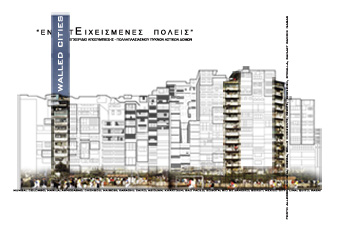

In my Thesis I ’ve continued working on the concept that was posed and developed in my research project, entitled “Wells as spatial metaphors of the self (ego) in literature”. This project referred to, commented on, and correlated literature texts involving a particular kind of space : frear (the well in ancient greek) and then was attempted a parallelism of this space with the ego and the most basic part of it, the memory.
On this project the concept of the “frear” was used as an analog of the vertical interstitial empty spaces between high-rise buildings in big modern cities, a kind of “urban well”, an empty space that disrupts the continuity of the front of the city. In order to use the contrast of the empty well with the solid ground (it’s very obvious on the cross section) as a tool in rereading the cities, I ’ve chosen to work with cities of the highest density globally, such as favellas in Rio de Janeiro and Mexico, Kowloon in Hong Kong and other slums. My study focused on the successive elevations of the buildings of slums, walls, city-fronts, external borderlines. I was especially interested in the contrasting spatial relations that develop on walled cities, such as of light and shadow, or empty and full, or niche and extrusion. Then diagrams and models were made to represent these relations. Moreover, social, political and financial factors were taken into consideration, data that created this kind of structures and buildings, spatial projections of these particular factors. The aspect of the highest importance was the urbanistic tendencies that led to these organic kind of structures.
The final product of this research is a manual, a diagram with lists of the notions that were researched. The diagram (like an array) has horizontal and vertical columns organized according to the main notional units. The horizontal categories are four: 1. the first kind of space that I worked with (well), 2. the space that was firstly parallelized with the well (Ego), 3-4. the buildings and the city, where this whole “well” concept could find its urban analog (the scale becomes bigger enough to approach the architectural reality of walled slums). These four horizontal columns are combined on this board to five vertical, that include the notions that were used as tools to analyze the horizontal ones. The vertical ones are : the infrastructure, the structural contrasting relation “empty – full” , the city-fronts, the social status, and finally the intervention strategies (referring only to buildings and cities).
The diagram that was designed has horizontal and vertical organization of all these notions, and acts as a field condition of multiple possible paths, which give different results according to the way of combining the parts. An example could be Α VI 3-5 – B III 1-3 – Δ ΙΙΙ 4 – Ε VI 1 a random choice is a net of nodes, links routes, free and coincidental or result of thinking and planning, they lead to proposals in order to improve the living conditions in the slums. If we see this whole project more freely, these routes could refer to any city under different circumstances.
This “system” is nothing but a proposal to the difficult problem of the slums, but it does not claim to be capable of dealing with this particular urban matter as a whole. On the contrary, it provides spotted, small scale interventions, which occur to “weak” spots, places where people suffer more, where small “breaths” are necessary and relieving. If someone wanted to face this fact as a whole, (as many dictatorships have already done) one solution could be the bulldozer. But every sensitive man would be opposed to such an act, which directly hurts other people. When squatters are forced to be transported into megablocks they are miserable and unhappy, as these structures are not designed according to their needs. So, small scale, “surgery operations” would help the light and the air get into the walled cities maintaining the continuity of the front of the city.
Supervisor: Gavrilou Evelyn
Reference Number: 326


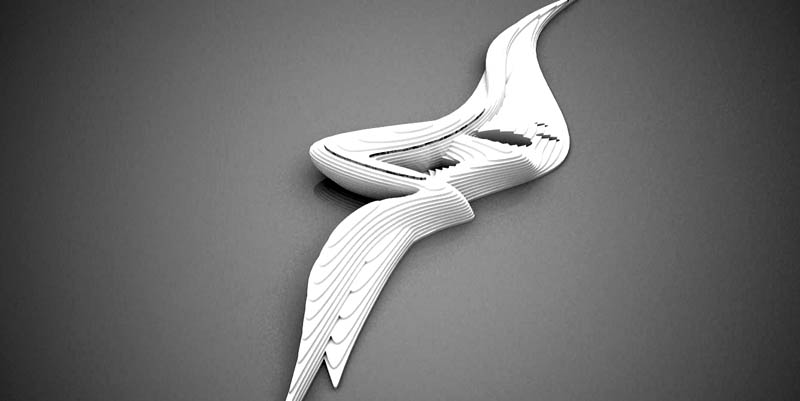

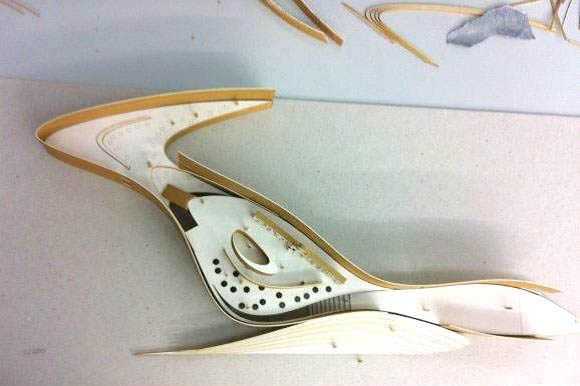

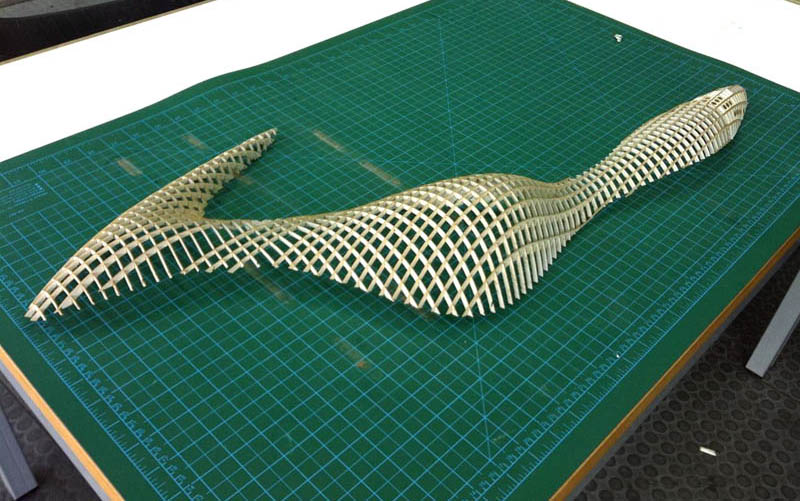

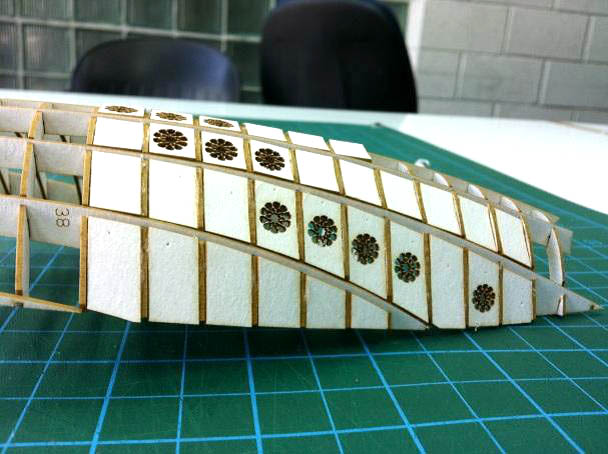



The final thesis project is the design of the Afghan pavilion for the Expo 2015 in Milan. Aim of the design is to generate a contemporary monument of Afghan culture and tradition offering a space experience with different experience levels. Inspiration has been taken from the following elements: calligraphy, local architecture, traditional geometric decorative patterns, country’s landscape, place’s history and handcrafts.
Supervisors: Papadopoulos Spiros, Koen Aaron
Reference Number: 340
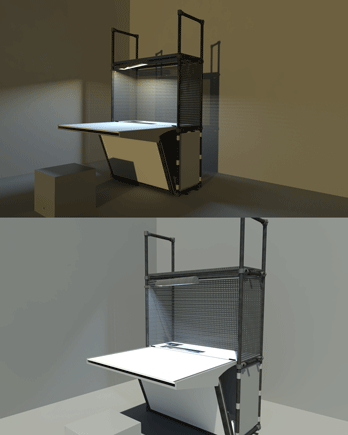

De|sto|reunit is a basic residential working machine. It came up as an essential personal need for familiarization of the minimum required space of the academic building and it is mostly referred to students of architecture and equivalent schools.
De|sto|reunitserves three basicstudent’sneedsthatarisethroughouthisdiplomatproject: working (hand-drawn and computer design, model construction), storing (tools, material and personal belongings) and rest (temporary relax, short break from work).
In order to minimize the space that these three procedures require, they were put in layers vertically. Thus, a metal structure was designed on which ‘function shelves’ are adapted with reference to building scaffolding.
Substantial parts of the unit are a work surface –table, a resting area –floor, a fabric canopy – isolation tent and many storage spaces. Construction is completed with a retractable chair – storage box and an included adjustable lamp.
De|sto|reunit functions dependant upon the building it is placed in, using some of its facilities (plug-in, wireless internet), whereas it is possible for it to be multiplied.
Supervisor: Psychoulis Alexandros
Reference Number: 362


The aim of the dissertation is the dessign of counter-spaces, namely the design of situations on already existing sites with predefined functions. For this purpose, a design methodology was developed based on gaming, not as an end result but rather as a design game where different forms of spaces arise that surround different actions and behaviors. Choosing three points of pedestrian traffic on a central avenue in Athens, the pedestrian bridge, the vertical channels and the pedestrian crossing the design was based on three of type of games, defined by Caillois as simulation, vertigo and competition. At each point a game type was applied, based on the data of each space, its use and its relationship to the central avenue.
Supervisor: Gavrilou Evelyn
Reference Number: 353
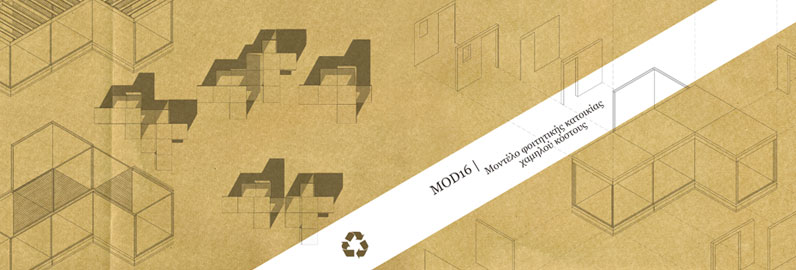

Every year thousands of students visit the cities where there are going to live for the next few years of their lives, seeking the ideal home in which the will live until the end of their studies. The university housing facilities are not capable to cover the students housing needs. So, their families have to support them economically, spending a big amount of money for housing as well as for the furniture. In every student city a lot of people try to take advantage of that need and make a profit out of it in expense of the students and their families leasing their problematic apartments with high rents.
This thesis project is about the issues stated above and moreover suggests the creation of a low cost and disposable student house. The low cost is due to the cheap materials from which each house is built. The specificity of this project is that the house is made of cardboard, as a reference to the fact that the final shape derived from the folding of a square paper divided in sixteen blocks. The design of the rooms was made based on the student’s needs according to a research that was carried out for this purpose. Thus, the student is able to choose the module that fulfills his/ hers needs and place it wherever there is space in the city. This thesis project focuses on the construction procedure of the house, which is going to be bought as a package and be reassembled by the student himself. After the conclusion of his/ hers studies the module is going to be recycled.
Supervisors: Vyzoviti Sophia, Manolidis Kostas
Reference Number: 345
In times of crisis, the unavoidable disruption that occurs between persons or communities and the system results in the disconnection of the former from the urban network and the emergence of a new need for immediate relocation. Based on the above, we attempt to set the parameters of an experiment where a series of abandoned industrial spaces, located in the suburbs, accumulate infrastructure in order to tend to the possibility of a temporary accommodation of transitive users. These entropic islands, unspecified in space and time, conditioned by varying rates of decay, are reintroduced into a network in the context of a dispersed city that challenges the usual experience of travelling by car, which is formed through a fragmented spatial view and a perceived as abrupt shift in geographic continuance, replacing it with a potentially infinite transposition that is combined with the possibility of a temporary stop or shelter. For this purpose, transitional surfaces are produced by a process of destroying and re-categorizing selected items that already exist in the particular space. These new surfaces can be used both as interconnecting platforms and as voluntary reclusion shelters. In essence, we are trying to built a new environment for socializing which redefines the concept of infrastructure, enables the user’s attempt to connect to more conceptual and personal networks and envelops work as a spontaneous event, an unformatted action which momentarily crosses paths with transposition.
Supervisors: Dallas Alexis, Paniyiris Costis
Reference Number: 344


The thesis «Odette| ideal destructions" is an interpretation of the classical choreography of 1871, the Swan Lake. This interpretation, through the original plot of the myth, alternating between the two spatial conditions, the lake and castle, and the relationships formed in these two environments, is trying to revisit issues of symmetry and idealization today. The axis of symmetry, remaining part of the sublimation process during the Renaissance and Romanticism, becomes the tool of the present reinterpretation of symmetry.
The Villa Rotonda of A. Palladio, the ultimate example of symmetrical design and a personal algorithm, interact and produce a minimum design area, the surface. The surface is multiplied, destroyed and hence composes a score of the new space and motion choreography, which is constantly redefined. But also, the relationship of the bodies of the two heroes is redefined. The same means of idealization, similar to the process of idealization of the classical dancer, the axis of symmetry, intervenes both to the structure of the body and the process of integration /idealization of both sexes. The new body, more fluid, completely idealized and finally dehumanized, brings back the question of integration.
Overall, the process of idealization and destruction in reverse, is trying to be read through a performance of the modern heroine. The hybrid and idiosyncratic space which is eventually produced, does not pretend to give absolute answers, but rather to make a nostalgic question about the role of idealization today and its design principles.
Supervisor: Psychoulis Alexandros
Reference Number: 332


In a degraded region, like Perama, where the boundaries in several places, between industry and residents are not quite clear, I suggest the recreation of a deserted area in an industrial zone and the creation of a pleasure park which will serve the neighborhood and the municipality as well.
The intervention site comes from the reformation of the boundaries between the urban region and the oil facilities, according with the contemporary attitude towards the removal of the industry from the residential zone in order to develop the whole region.
Besides the small groves and the green spaces, the new recreational park has the necessary public spaces, for young and older people. Among the new facilities it includes a research center and cultivations of energy plants in order to give a “green” continuity from the industrial use of the site, as a former storage of liquid fuel.
The shape of the project comes from the tangents in the existing fuel tanks. The new lines that accrue are being prioritize and the triangular surfaces “get fill” with uses. Three different layers are formed, which are putted on the sharp slope composing the final result.
The industrial area with the intense cylinder components is being maintained by contending the indoor facilities inside the fuel tanks. The geometry of the later is being maintained, while all the others are being subtracted from the topography composing the impression of void-complete.
The aesthetic of the site borrows elements from the former industrial use. In several places the current state of the fuel tanks and the terrain are being maintained, while the other places remain simple and are composed in accordance to the scale that is being suggested by the usage.
Supervisors: Fyga Dimitra, Tsangrassoulis Aris
Reference Number: 317

